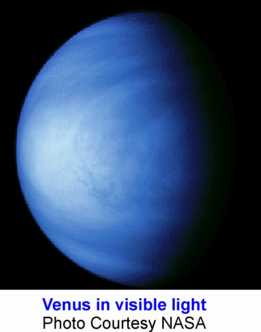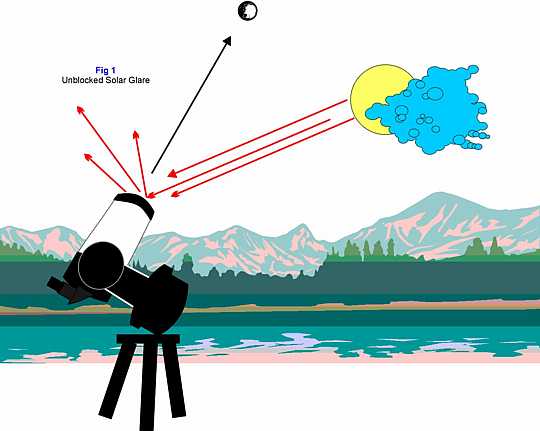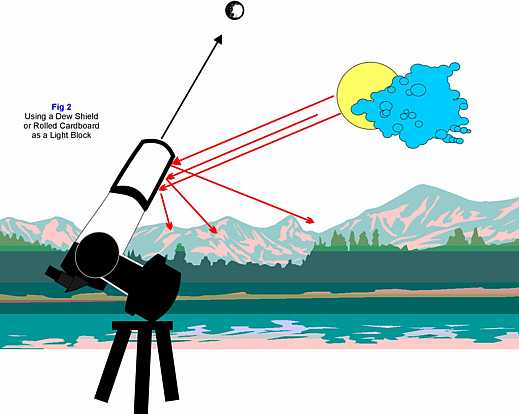DAYLIGHT OBSERVING
Last updated: 3 April 2001
DAYLIGHT OBSERVING |
Introduction -
Most of you have in your possession a telescope that is truly a "wonder of the world" in that it can determine locations of objects, tell you where they are in the sky....and ZERO IN on them....without you ever looking through the telescope. The modern computerized "GO TO" telescopes can take you on a tour of the majority of Messier objects in one night's observing....zip through hundreds of NGC-listed galaxies and tour the stars by name at your leisure.
But consider the following scenario:
1) you work the night shift and the sky is "all gone" when you finally get home, and the telescope sits in its corner awaiting your first slew to knock the cobwebs from the gearwork;
2) you've had a bad bout of weather and it seems like every night is cloudy, but the days are clear...what gives?
3) Venus and Mercury are both showing extremely favorable and large crescent shapes during their inferior conjunctions but they are "too close" to the sun to see in the morning or evening sky;
4) you have just heard about a very wonderful lunar occultation of the bright star Antares by the moon....but the darned thing happens just after 3 p.m. in the afternoon, and the moon is but a thin crescent and you can't see it with the naked eye!
5) or, you're just bored to death and cannot wait until nightfall to "look at" something.
If this sounds like you....then DAYTIME OBSERVING may be just for you!
-----------------------------------
GO TO TELESCOPES AND DAYLIGHT OBSERVING -
On extremely clear - "deep blue" - days there are a remarkable array of celestial objects that can actually be observed during daylight. The trouble has always been knowing WHERE to look for them.
In the "old days" we had to rely on setting circles to find the objects, and had no way of semi-accurately aligning to north for precision pointing, even using those mechanical circles. Also, the only reference point from which to "set" the circles would be the sun itself.
Nonetheless, that archaic method of finding daytime objects was satisfactory....until computerized telescopes could find them for us with a lot less hassle...and a lot more accurately.
Among the objects that can be observed in daylight (very deep clear skies needed....low humidity, no haze, no pollution) are:
- Venus - Mercury - Mars at Perihelion - Saturn (when the sun is very low) - the Moon - the brightest Stars - "sungrazing" comets - and, of course...the Sun.

On the bright inferior planets Venus and Mercury more detail amidst the scintillating brightness of the planet can be seen during daylight than at night. The photo above (courtesy NASA) shows Venus in visible light (as your eyes would see it) and demonstrates some of the cloud patterns that can actually be seen in amateur telescopes during daylight observing.
In fact, the best time to observe the fascinating crescent phase of Venus and when both it and Mercury are LARGEST as we see from Earth is when it is at INFERIOR CONJUNCTION, very much between the Earth and sun and consequently always see during brightened skies.
Likewise, occultations of the brighter stars by the moon DO take place frequently in daylight hours; and there are daylight times that these bright stars can be OCCULTED by asteroids, thus causing them to seemingly "blink out" of visibility....all this CAN be observed without much difficulty with your GO TO telescope.
Following is a brief description of the two most important aspects of daylight observing:
1) how to acquire (find) the objects with a GO TO scope; and,
2) how to properly observe these objects for maximum definition and least sky/sun glare.
--------------------------------
SETTING UP YOUR ETX, DS OR LX FOR DAYLIGHT OBSERVING -
Finding objects in daylight is easy with your computerized telescope, and not at all unlike using the telescope at night. Patience at the eyepiece is the key factor as your eyes will play tricks on you as you attempt to actually "see" the object superimposed in a bright blue sky.
NOTE: other than Mercury, Venus, Jupiter and the Moon, objects will NOT be visible in either the 8 x 21 finder for the ETX or DS scopes nor the 8 x 50 finder with the LX 90. You will be required to use the lowest magnification possible for your main telescope and attempt to acquire the object in its field of view!
Follow these easy steps for your next daytime astronomy outing:
1) Achieve focus the night before with your lowest power, widest field eyepiece. The most difficult of daylight observing is attempting to determine FOCUS. If you are not focused just right, NOTHING will be visible, even if it is dead-center! An out-of-focus image blends much too quickly into the bright blue sky that you will see in your eyepiece! Another alternative to prior-night focusing (it will be right at the last place you observed a nighttime object...there is no difference in daylight and nighttime celestial focusing of course...just make sure you use the SAME eyepiece as the night before, as no eyepieces are truly parfocal) will be to use the SUN to focus on prior to setting up; this should ONLY be done when a proper solar filter of optical glass is in place over the front of the telescope!
2) Set up your telescope per the instructions, just as you would at night: level the tripod, place the telescope in "Home Position", initialize, and then do the "Setup/Align/Easy...." two star method;
3) When AutoStar takes you to each of the two alignment stars, merely press "enter" when you hear the beep; do not attempt to even locate the stars....if your setup in home position and leveling was accurate, you will be a lot closer than you might imagine!
4) Unless you really messed up, AutoStar will now come back and tell you "Alignment Successful" and your clock drives will engage and you are ready to GO TO something during the day!
5) Just like at night (let's say you are looking for Venus), merely press "Select/Object/Solar System/Venus.." enter and the telescope will take you remarkably close to the planet which should be somewhere close to the field of your wide field eyepiece; give the telescope time to complete its GO TO slew and do not do anything until you hear the "beep" and the object's data is listed on the AutoStar screen;
6) If you do not find it immediately, allow your eyes time to adjust to the brilliant sky and lack of contrast...the object may, indeed, be in the field of view! If you still do not see it and are reasonably sure it is NOT in the field of view, hold down the "ENTER" key for about 3 seconds and do the "Spiral Search" which will initiate the telescope to begin moving in ever-larger squares outward until you stop it by pressing "Mode." (note: this feature is found only on the new versions v2.1ek firmware which can be loaded into all AutoStars).
--------------------------------
WAYS TO INCREASE YOUR CONTRAST AND OBJECT VISIBILITY -
Once you have found your object you may have difficulty getting a good image for three reasons:
1) during daylight, the radiant heat from the ground typically interferes with steady seeing; likewise the telescope tube assembly is absorbing heat and those internal currents will greatly degrade the image on some occasions;
2) sunlight in your eyes interferes with your eyesight and your ability to concentrate on the image;
3) there is considerable glare and light flares that are entering your optical tube as a result of direct sunlight.
Unfortunately there is nothing that can control #1) above; we are at the mercy of our atmosphere and daily climate; however, observing early in the morning hours is preferred prior to ground warming to steady air currents; likewise, you can attempt to observe with your telescope IN SHADE (under a porch or a tree) and aimed into the open sky toward your object, to reduce telescope heating.
As for sunlight in your eyes, use the same trick that "old timer" photographers had to use....put a dark cloth over your head and shield your eyes from direct sunlight. This is even a good option for nighttime observing as well. It is amazing the difference you will see in both image contrast and your ability to focus/concentrate on what is being shown!
Figure 1 shows the effect of #3) above, the serious problem of extraneous sunlight reflecting off of your front telescope element as well as entering the tube itself; both the reflection and the intrusion of light will totally break down your image sharpness.

As you can see, the nature of the design of the ETX and LX series (as well as all other Schmidts and Maksutovs) is such that the front glass element is exposed well into the outer opening of the tube and thus very easily in the path of direct sunlight. The Newtonian DS series does not have such as big a problem as the main optical component (the mirror) is located well toward the bottom and shielded from the light!

The very simple solution to greatly enhance your contrast and image quality on the ETX and LX telescopes is to simply provide a light shield that blocks direct sunlight from striking the front optical element as shown in Figure 2.
This can be accomplished by a simple "dew shield" that is commercially available in all colors, fabrics and feels, or simply by rolling up a piece of "poster board" into a tube which slips down over the front of the optical tube assembly of your telescope!
To adequately block extraneous solar rays, the rule of thumb is that the shield must be TWO TIMES longer than the lens/corrector plate is in diameter....thus if you have a 3.5" ETX 90, then make your cardboard tube about 7" in total length extended beyond your front surface.
You will be amazed at the difference in clarity and contrast so simple a device makes. As a matter of fact this is an EXCELLENT tool to also use when observing celestial objects that are VERY CLOSE TO THE BRIGHT MOON at nighttime as well. Anytime the moon is quarter or more illuminated in the sky and you wish to observe even a bright objects such as a planet, a light shield will greatly improve your observing.
---------------------------------
So, not only do our GO TO telescopes open up the frontier of distant galaxies and intriguing nebulous filaments of deep space in the darkened recesses of night....they also allow us the freedom of exercising a little astronomy in daylight hours as well.
It's time to put on the shades, roll up your sleeves, dab on the sunscreen and go outdoors and "gather a few rays".... and explore the brighter side of your GO TO telescope!
P. Clay Sherrod
Arkansas Sky Observatory
Conway / Petit Jean Mountain
Arkansas
Return to the top of this page.
Go back to the Observational Guides & References page.
Go back to my ETX Home Page.